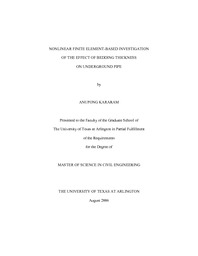
ATTENTION: The works hosted here are being migrated to a new repository that will consolidate resources, improve discoverability, and better show UTA's research impact on the global community. We will update authors as the migration progresses. Please see MavMatrix for more information.
Show simple item record
| dc.contributor.author | Kararam, Anupong | en_US |
| dc.date.accessioned | 2007-08-23T01:56:12Z | |
| dc.date.available | 2007-08-23T01:56:12Z | |
| dc.date.issued | 2007-08-23T01:56:12Z | |
| dc.date.submitted | July 2006 | en_US |
| dc.identifier.other | DISS-1390 | en_US |
| dc.identifier.uri | http://hdl.handle.net/10106/164 | |
| dc.description.abstract | The pipe-soil interaction is studied by using the finite element software, ABAQUS/CAE Version 6.5-1 as a symmetric model of embankment installation to study the effect of bedding property and thickness on pipe-soil interaction with increase in the height of fill. A three-dimensional finite element model (FEM) of the concrete pipe and surrounding soil is developed. The FEM is capable of simulating material, geometric, and contact nonlinearities which employs a nonlinear incremental solution algorithm. Several different element types and mesh size were tested to obtain the optimum converged mesh. These elements were eight-noded linear brick (C3D8R) and six-noded linear triangular prism (C3D6) for modeling of the concrete pipe and surrounding soil. The behavior of the 3-D model is investigated by varying the pipe diameter, backfill height, bedding thickness, and bedding material. Three material constitutive relationships of soil involving in the model are gravelly sand (Sn), sandy silt (Si), and silty clay (CL).
To study the effect of bedding thickness on the pipe wall, due to the increment of backfill soil depth, contact elements were employed in the interface between each two regions. The lateral boundaries and model length were also studied for the converged solution. A parametric study was conducted to study the effects of bedding thicknesses 3 in (7.5 cm), 5 in (12.5 cm), 7 in (17.5 cm), and 9 in (22.5 cm) with backfill heights 20 ft (6 m), 40 ft (12 m), 60 ft (18 m), 80 ft (24 m), and 100 ft (30 m). The different types of material used for the inside bedding zone are as follows: Si70; Si90; Sn85; and Sn90. The results show the increase in bedding thickness reduces tensile stress at crown, springline, and especially invert of the pipe wall depending on the material property. This means the change in material property and compaction level has a greater effect on the reduction of tensile stresses than the effect from the variation of bedding thicknesses. Also, materials with lower bedding stiffness (high deformability characteristics) cause greater reduction in induced stresses. This study shows that for commonly used bedding material (Sn90), the effect of the increase in bedding thickness has a minimal effect on stress reduction of the pipes studied. | en_US |
| dc.description.sponsorship | Abolmaali, Ali | en_US |
| dc.language.iso | EN | en_US |
| dc.publisher | Civil & Environmental Engineering | en_US |
| dc.title | Nonlinear Finite Element-based Investigation Of The Effect Of Bedding Thickness On Underground Pipe | en_US |
| dc.type | M.S.C.E. | en_US |
| dc.contributor.committeeChair | Abolmaali, Ali | en_US |
| dc.degree.department | Civil & Environmental Engineering | en_US |
| dc.degree.discipline | Civil & Environmental Engineering | en_US |
| dc.degree.grantor | University of Texas at Arlington | en_US |
| dc.degree.level | masters | en_US |
| dc.degree.name | M.S.C.E. | en_US |
| dc.identifier.externalLink | https://www.uta.edu/ra/real/editprofile.php?onlyview=1&pid=958 | |
| dc.identifier.externalLinkDescription | Link to Research Profiles | |
Files in this item
- Name:
- umi-uta-1390.pdf
- Size:
- 1.181Mb
- Format:
- PDF
This item appears in the following Collection(s)
Show simple item record


